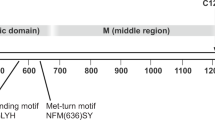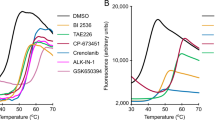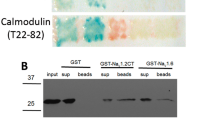Abstract
The Ca2+-dependent cysteine proteases, calpains, regulate cell migration1, cell death2, insulin secretion3, synaptic function4 and muscle homeostasis5. Their endogenous inhibitor, calpastatin, consists of four inhibitory repeats, each of which neutralizes an activated calpain with exquisite specificity and potency6. Despite the physiological importance of this interaction, the structural basis of calpain inhibition by calpastatin is unknown7. Here we report the 3.0 Å structure of Ca2+-bound m-calpain in complex with the first calpastatin repeat, both from rat, revealing the mechanism of exclusive specificity. The structure highlights the complexity of calpain activation by Ca2+, illustrating key residues in a peripheral domain that serve to stabilize the protease core on Ca2+ binding. Fully activated calpain binds ten Ca2+ atoms, resulting in several conformational changes allowing recognition by calpastatin. Calpain inhibition is mediated by the intimate contact with three critical regions of calpastatin. Two regions target the penta-EF-hand domains of calpain and the third occupies the substrate-binding cleft, projecting a loop around the active site thiol to evade proteolysis.
This is a preview of subscription content, access via your institution
Access options
Subscribe to this journal
Receive 51 print issues and online access
$199.00 per year
only $3.90 per issue
Buy this article
- Purchase on Springer Link
- Instant access to full article PDF
Prices may be subject to local taxes which are calculated during checkout




Similar content being viewed by others
References
Franco, S. J. & Huttenlocher, A. Regulating cell migration: calpains make the cut. J. Cell Sci. 118, 3829–3838 (2005)
Wang, K. K. Calpain and caspase: can you tell the difference? Trends Neurosci. 23, 20–26 (2000)
Harris, F., Biswas, S., Singh, J., Dennison, S. & Phoenix, D. A. Calpains and their multiple roles in diabetes mellitus. Ann. NY Acad. Sci. 1084, 452–480 (2006)
Liu, J., Liu, M. C. & Wang, K. K. Calpain in the CNS: from synaptic function to neurotoxicity. Sci. Signal. 1, re1 (2008)
Kramerova, I., Beckmann, J. S. & Spencer, M. J. Molecular and cellular basis of calpainopathy (limb girdle muscular dystrophy type 2A). Biochim. Biophys. Acta 1772, 128–144 (2007)
Wendt, A., Thompson, V. F. & Goll, D. E. Interaction of calpastatin with calpain: a review. Biol. Chem. 385, 465–472 (2004)
Moldoveanu, T. et al. A Ca2+ switch aligns the active site of calpain. Cell 108, 649–660 (2002)
Suzuki, K., Hata, S., Kawabata, Y. & Sorimachi, H. Structure, activation, and biology of calpain. Diabetes 53, S12–S18 (2004)
Hosfield, C. M., Elce, J. S., Davies, P. L. & Jia, Z. Crystal structure of calpain reveals the structural basis for Ca2+-dependent protease activity and a novel mode of enzyme activation. EMBO J. 18, 6880–6889 (1999)
Elce, J. S., Hegadorn, C., Gauthier, S., Vince, J. W. & Davies, P. L. Recombinant calpain II: improved expression systems and production of a C105A active-site mutant for crystallography. Protein Eng. 8, 843–848 (1995)
Todd, B. et al. A structural model for the inhibition of calpain by calpastatin: crystal structures of the native domain VI of calpain and its complexes with calpastatin peptide and a small molecule inhibitor. J. Mol. Biol. 328, 131–146 (2003)
Bode, W. & Huber, R. Structural basis of the endoproteinase–protein inhibitor interaction. Biochim. Biophys. Acta 1477, 241–252 (2000)
Cuerrier, D., Moldoveanu, T. & Davies, P. L. Determination of peptide substrate specificity for μ-calpain by a peptide library-based approach: the importance of primed side interactions. J. Biol. Chem. 280, 40632–40641 (2005)
Cuerrier, D. et al. Development of calpain-specific inactivators by screening of positional scanning epoxide libraries. J. Biol. Chem. 282, 9600–9611 (2007)
Moldoveanu, T., Campbell, R. L., Cuerrier, D. & Davies, P. L. Crystal structures of calpain–E64 and –leupeptin inhibitor complexes reveal mobile loops gating the active site. J. Mol. Biol. 343, 1313–1326 (2004)
Betts, R., Weinsheimer, S., Blouse, G. E. & Anagli, J. Structural determinants of the calpain inhibitory activity of calpastatin peptide B27-WT. J. Biol. Chem. 278, 7800–7809 (2003)
Betts, R. & Anagli, J. The beta- and gamma-CH2 of B27-WT’s Leu11 and Ile18 side chains play a direct role in calpain inhibition. Biochemistry 43, 2596–2604 (2004)
Moldoveanu, T., Hosfield, C. M., Jia, Z., Elce, J. S. & Davies, P. L. Ca2+-induced structural changes in rat m-calpain revealed by partial proteolysis. Biochim. Biophys. Acta 1545, 245–254 (2001)
Kiss, R. et al. Calcium-induced tripartite binding of intrinsically disordered calpastatin to its cognate enzyme, calpain. FEBS Lett. 582, 2149–2154 (2008)
Reverter, D. et al. Flexibility analysis and structure comparison of two crystal forms of calcium-free human m-calpain. Biol. Chem. 383, 1415–1422 (2002)
Strobl, S. et al. The crystal structure of calcium-free human m-calpain suggests an electrostatic switch mechanism for activation by calcium. Proc. Natl Acad. Sci. USA 97, 588–592 (2000)
Pal, G. P., De Veyra, T., Elce, J. S. & Jia, Z. Crystal structure of a micro-like calpain reveals a partially activated conformation with low Ca2+ requirement. Structure 11, 1521–1526 (2003)
Davis, T. L. et al. The crystal structures of human calpains 1 and 9 imply diverse mechanisms of action and auto-inhibition. J. Mol. Biol. 366, 216–229 (2007)
Moldoveanu, T., Hosfield, C. M., Lim, D., Jia, Z. & Davies, P. L. Calpain silencing by a reversible intrinsic mechanism. Nature Struct. Biol. 10, 371–378 (2003)
Blanchard, H. et al. Structure of a calpain Ca2+-binding domain reveals a novel EF-hand and Ca2+-induced conformational changes. Nature Struct. Biol. 4, 532–538 (1997)
Lin, G. D. et al. Crystal structure of calcium bound domain VI of calpain at 1.9 Å resolution and its role in enzyme assembly, regulation, and inhibitor binding. Nature Struct. Biol. 4, 539–547 (1997)
Dutt, P., Arthur, J. S., Grochulski, P., Cygler, M. & Elce, J. S. Roles of individual EF-hands in the activation of m-calpain by calcium. Biochem. J. 348, 37–43 (2000)
Jia, Z. et al. Mutations in calpain 3 associated with limb girdle muscular dystrophy: analysis by molecular modeling and by mutation in m-calpain. Biophys. J. 80, 2590–2596 (2001)
Saez, M. E., Ramirez-Lorca, R., Moron, F. J. & Ruiz, A. The therapeutic potential of the calpain family: new aspects. Drug Discov. Today 11, 917–923 (2006)
Hanna, R. A., Campbell, R. L. & Davies, P. L. Calcium-bound structure of calpain and its mechanism of inhibition by calpastatin. Nature 10.1038/nature07451 (this issue)
Sambrook, J., Fritsch, E. F. & Maniatis, T. Molecular Cloning: A Laboratory Manual (Cold Spring Harbor Laboratory Press, 1989)
Delaglio, F. et al. NMRPipe: a multidimensional spectral processing system based on UNIX pipes. J. Biomol. NMR 6, 277–293 (1995)
Johnson, B. A. Using NMRView to visualize and analyze the NMR spectra of macromolecules. Methods Mol. Biol. 278, 313–352 (2004)
McCoy, A. J. et al. Phaser crystallographic software. J. Appl. Cryst. 40, 658–674 (2007)
Collaborative Computational Project, Number 4. The CCP4 suite: Programs for Protein Crystallography. Acta Crystallogr. D 50, 760–763 (1994)
Winn, M. D., Isupov, M. N. & Murshudov, G. N. Use of TLS parameters to model anisotropic displacements in macromolecular refinement. Acta Crystallogr. D 57, 122–133 (2001)
Brünger, A. T. et al. Crystallography and NMR system: a new software system for macromolecular structure determination. Acta Crystallogr. D 54, 905–921 (1998)
McRee, D. E. A visual protein crystallographic software system for X11/XView. J. Mol. Graph. 10, 44–46 (1992)
Acknowledgements
We thank P. L. Davies for facilitating the initial stages of this work and for sharing the coordinates for the calpastatin repeat 4–calpain complex, M. Osborne for help with the NMR analysis, B. Schulman for collecting the ALS synchrotron data, the staff at Brookhaven National Light Source beam X29 and APS SERCAT for help with data collection, S. White and D. Miller for advice and sharing of synchrotron time, and C. Hosfield, A. Tocilj and R. Kriwacki for reviewing our manuscript. Funding was provided by the US National Institute of Health and National Cancer Institute, the Canadian Institute of Health Research and the American Lebanese Syrian Associated Charities.
Author Contributions T.M. performed the experimental work and data analysis. T.M., K.G. and D.R.G. were involved with the project planning and wrote the paper.
Author information
Authors and Affiliations
Corresponding author
Supplementary information
Supplementary Information
This file contains Supplementary Figures 1-13 with Legends, Supplementary Tables 1-3 and Supplementary References (PDF 3856 kb)
Supplementary Movie
This Supplementary Movie file shows Calpain activation by Ca2+. The free and Ca2+- bound calpains were overlapped based on DIII and are colored as in Fig. 3. Morphing coordinates were generated using LSQMAN16 to produce the individual frames of the movie. The catalytic triad in DI-II is highlighted in orange. (AVI 6301 kb)
Rights and permissions
About this article
Cite this article
Moldoveanu, T., Gehring, K. & Green, D. Concerted multi-pronged attack by calpastatin to occlude the catalytic cleft of heterodimeric calpains. Nature 456, 404–408 (2008). https://doi.org/10.1038/nature07353
Received:
Accepted:
Issue Date:
DOI: https://doi.org/10.1038/nature07353
This article is cited by
-
Ca2+ activity signatures of myelin sheath formation and growth in vivo
Nature Neuroscience (2018)
-
Calpain research for drug discovery: challenges and potential
Nature Reviews Drug Discovery (2016)
-
The Role of Proteases in Hippocampal Synaptic Plasticity: Putting Together Small Pieces of a Complex Puzzle
Neurochemical Research (2016)
-
Gene/protein expression of CAPN1/2-CAST system members is associated with ERK1/2 kinases activity as well as progression and clinical outcome in human laryngeal cancer
Tumor Biology (2016)
Comments
By submitting a comment you agree to abide by our Terms and Community Guidelines. If you find something abusive or that does not comply with our terms or guidelines please flag it as inappropriate.



